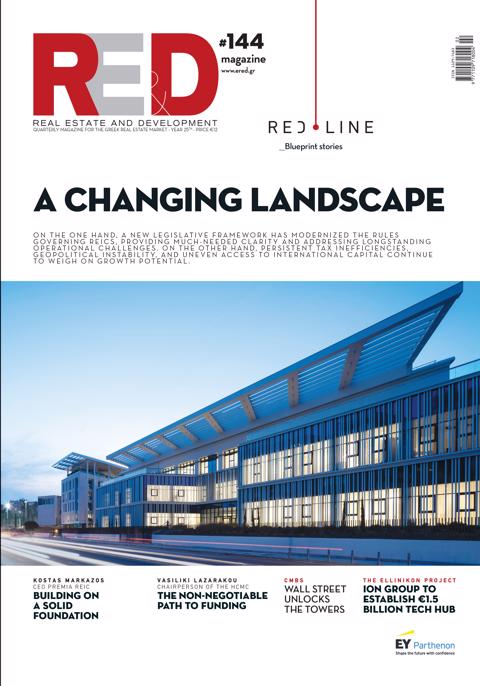
Macroeconomics & real estate in turmoil times
Headwinds to the global economy have intensified in the course of 2022 and the outlook has deteriorated in the face of surging inflation, tighter financial conditions and elevated geopolitical risks.
The war in Ukraine continues to unsettle energy and food commodity markets, thus leading to increased price volatility and fueling uncertainty about the future outlook. In China, the continuation of the zero-COVID policy and the contraction in the residential sector are weighing further on economic activity.
Survey data point to a broad-based moderation in economic activity and trade at the turn of the year. The global composite PMI indices peaked in Q2 2021 and have since been on a downward trajectory. In October 2022, they fell below the threshold of 50, suggesting contraction of the global economy. Flash composite PMI indices in advanced economies contracted even further in November. Furthermore, consumer confidence in AEs, notably in the US, the UK and the euro area, have declined to multi-year lows as high and persistent inflation is taking a toll on real disposable income of households.
Across major advanced economies, the deceleration in economic activity during 2022 has been driven by surging energy prices, slowing demand and tighter financial conditions. Monetary policy tightening has also contributed to lower GDP growth since the beginning of the central bank tightening cycle in early 2022, while declining oil prices have started to support growth in the third quarter.
Global inflation remains stubbornly high. Headline consumer price inflation in OECD countries increased to above 8% and core inflation is currently just short of 6%. According to the latest readings, momentum in headline inflation appears to moderate amid a lower contribution of energy prices. However, core inflation will continue to increase for some time as higher energy and food prices pass-through to consumer prices.
In response to the surge in inflation, many central banks around the world have increased interest rates and stopped large-scale asset purchases, or even announced quantitative tightening, as in the case of the Fed and other major central banks. Monetary policy normalisation is expected to have a negative impact on global growth. Moreover, the highly synchronised nature of these interest rate hikes raises concerns over the likelihood of a global recession.
Historically, synchronised inflation surges and interest rate hikes by a large number of central banks have been followed by global recessions. Since 1970 there have been four periods of highly synchronised inflation and interest rate hikes (1973, 1979, 1991 and 2007), each time followed by recessions in a large number of countries. According to ECB research, currently, more than 80% of countries in a wide sample of advanced and emerging market economies are experiencing a surge in inflation and more than 70% of central banks globally are hiking interest rates simultaneously.[1] At the same time, a large share of economies are slowing and in some cases heading into recession.
The main lesson from past experience for central banks is that neglecting or underestimating the global spillovers of monetary policy tightening during periods of surging inflation may lead to overtightening and a significant cost to the real economy.
On the back of declining real incomes, tighter financial conditions and protracted energy market disruptions, global GDP is projected to grow well below long-term trends in 2023, and to recover gradually in 2024 and 2025. Rising inflation and tighter financial conditions are projected to take a toll on economic activity in advanced economies. EMEs are projected to fare somewhat better, possibly reflecting greater resilience to changing global financial conditions as a result of a reduction of macroeconomic vulnerabilities over recent decades. Nonetheless, cross- country heterogeneity is significant.
The outlook for global trade and euro area foreign demand is closely aligned to the one for global activity.
The balance of risks is tilted to the downside for growth and upside for inflation. Key risks concern more adverse effects from the war in the Ukraine, a significant growth slowdown in China and risks from over-tightening of monetary policy, particularly in key advanced economies. This could trigger a hard landing in these economies and a global recession via spillover effects.
On the other hand, slowing the pace of monetary tightening prematurely could raise the risk of de-anchoring of inflation expectations, thereby requiring possibly even tighter monetary policy in the future.
The current environment poses significant challenges on central banks and governments. Central banks need to continue tightening in order to protect price stability, even at the cost of lower demand. Fiscal policy can directly address re-distributional effects of inflation with measures that are targeted to the most vulnerable households and companies.
In this context, Greece has created additional fiscal space inter alia thanks to the timely imposition of a levy on electricity producers’ windfall profits, but also to the financing of a large part of total fiscal support measures from the Hellenic Energy Transition Fund, resulting in a smaller direct budgetary cost.
Targeted fiscal support could contain inflation in the near term, assuming it is budget-neutral over the medium term. A loose fiscal stance, on the other hand, may prompt debt sustainability concerns, notably in countries with high fiscal deficits and public debts. It could also dent central bank credibility if it casts doubt on the anti-inflation commitment, or threaten financial stability amid perceived risks of fiscal dominance.
Finally, energy policy should complement monetary and fiscal policies in taming inflation with measures that diversify energy supplies, enhance efficient energy consumption, and tackle excessive energy prices.
Turning to Greece, the impact of higher energy and food prices on Greece’s output has been limited so far.
Despite rising inflation and falling real disposable income, private consumption has kept up momentum, benefitting from the use of excess savings and the government’s income support measures to shield households from the surge in energy prices.
Growth has also been supported by strong export performance, a strong rebound in tourism and investment activity. Looking forward, GDP growth is expected to decelerate significantly in 2023 due to a slowing external demand, tighter financial conditions, increased uncertainty and severely hit confidence. Nevertheless, the Greek economy is expected to perform better than the euro area, as NGEU funding will continue to support investment.
What are the implications of the current economic environment and outlook for real estate investors? Let me start with some general observations regarding real estate as an asset class. Academic research utilising data extending over nearly 150 years across 16 advanced economies suggests that real estate has provided real (i.e. inflation adjusted) returns of about 7% on average, comparable to the real return of equities.
[2] Importantly, risk, measured by the standard deviation of returns, is low for real estate investments, about half the risk of equities. Furthermore, the largest part of real estate returns is due to cash-flows, i.e. rents, as opposed to equities, for which most of the return is due to capital gains. This is an important stylised fact for investors, because cash-flows are a stable source of return as opposed to capital gains which is characterised by high volatility. These three characteristics (high returns, low risk and high cash-flow component) make real estate an attractive asset class for investors.
Nevertheless, real estate markets are not immune to the business cycle nor to changes in monetary conditions.
Looking at real estate from the point of view of demand and supply, the rise in prices of energy and raw materials will certainly affect negatively construction activity and supply of new homes. The rise in interest rates and the drop in real incomes of households will reduce home affordability and, hence, demand for residential property. The net effect on residential prices will depend on the relative magnitude of the decline in demand relative to supply. Since supply typically responds with a larger time lag to changes in economic conditions, the net effect will likely be a drop in prices.
Looking at real estate as an asset, which promises a stream of future cash flows to the investor, its fair price is given as the discounted value of net cash flows in form of future rents, net of maintenance costs. Hence, from the point of view of an investor, the price-to-rent ratio of a real estate investment must reflect market expectations of future rents and future risk-adjusted discount rates.
Price-to-rent ratios have increased over the past decade in a number of countries, reflecting the decline in interest rates amid a low inflation “low for long” interest rate environment in the global economy. Low interest rates have supported higher valuations in real estate markets not because they contributed to higher cash flow generation but because they increased the present value of a given stream of cash flows.
Seen from this perspective, rising inflation and higher interest rates have significant implications for real estate valuations. First, higher interest rates reduce the present value of future cash flows, putting downward pressure on prices. Second, however, rising inflation may also lead to higher rents, putting upward pressure on prices.
Real estate markets will be subject to these two opposing forces. Their net impact on market valuations is difficult to predict, as it depends on a number of factors, such as the persistence of inflation, the terminal interest rate of central banks, the duration and the extent of the economic slowdown, market volatility and investors’ risk appetite, to name just a few.
Let me close with a final remark.
The world has changed fundamentally due to a series of unforeseen and unprecedented supply shocks over the past three years. Life has become tougher for all of us, consumers, entrepreneurs, central banks, governments and investors. We all have to navigate through rough waters. Central banks will do their job to get inflation back to the target in a timely manner. Governments will continue supporting vulnerable households in order to minimise the social cost of high inflation. Firms must share the burden of high inflation with employees and consumers. Investors must learn that successful investments are not necessarily those that come with a low cost of financing but those, which generate value.
-----------------------------------------------------------------------------------------------------------------------------
[1] Alistair Dieppe and Davide Brignone (2022): Synchronised interest rate hikes, spillovers and risks to global growth | CEPR
[2] Oscar Jorda et al. (2019): The rate of return on everything:1870-2015. Quarterly Journal of Economics, pp. 1225-1298. https://doi.org/10.1093/qje/qjz012















